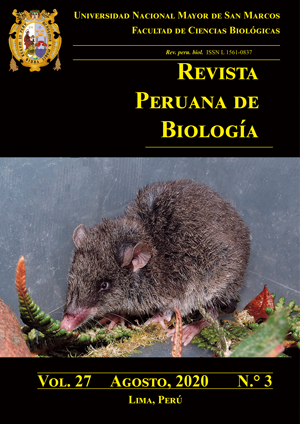Preferencia termal de machos adultos de Cryphiops caementarius previamente aclimatados a diferentes temperaturas
DOI:
https://doi.org/10.15381/rpb.v27i3.17262Palabras clave:
Cryphiops caementarius, camarón de río, comportamiento termal, dispersión termal, gradiente termal, termorregulaciónResumen
El objetivo fue determinar la preferencia termal de machos adultos de Cryphiops caementarius previamente aclimatados a diferentes temperaturas. Los camarones se colectaron del río Pativilca. En laboratorio, los camarones se aclimataron durante 30 días en nueve acuarios, cada uno con 10 recipientes circulares. En cada recipiente hubo un camarón (10 por acuario). Las temperaturas de aclimatación fueron de 19, 24 y 28 °C. El sistema de gradiente de temperatura (12 a 33 °C) fue una canaleta de PVC (3 m de longitud y 10 cm de profundidad) con 18 compartimentos. En un extremo de la canaleta se colocaron termorreguladores sumergibles (100W) y en el otro extremo, bolsas con hidrogel congeladas. La preferencia termal se determinó por el método agudo y las pruebas se realizaron entre las 08:00 y 14:00 h. Los camarones aclimatados a 24 °C se desplazaron a compartimentos cuyas temperaturas fueron más altas que la temperatura de aclimatación. Los camarones aclimatados a 24 °C se desplazaron a compartimentos cuyas temperaturas fueron alrededor de la temperatura de aclimatación. Los camarones aclimatados a 28 °C se desplazaron a compartimentos donde las temperaturas fueron más bajas que aquella de aclimatación. La preferencia termal de los camarones aclimatados a 19 °C fue de 22.7 °C, y la de los aclimatados a 24 °C fue de 24.8 °C, ambos sin diferencias significativas (p>0.05). En cambio, en los aclimatados a 28°C fue de 21.1 °C, que solo difirió (p<0.05) con los aclimatados a 19 °C. La preferencia termal final fue de 24.5 °C.
Descargas
Descargas
Publicado
Número
Sección
Licencia
Derechos de autor 2020 Walter Reyes-Avalos, Gladis Melgarejo Velásquez, Carmen Yzásiga Barrera, Karla Ferrer Chujutalli

Esta obra está bajo una licencia internacional Creative Commons Atribución-NoComercial-CompartirIgual 4.0.
LOS AUTORES RETIENEN SUS DERECHOS:
a. Los autores retienen sus derechos de marca y patente, y también sobre cualquier proceso o procedimiento descrito en el artículo.
b. Los autores retienen el derecho de compartir, copiar, distribuir, ejecutar y comunicar públicamente el artículo publicado en la Revista Peruana de Biología (por ejemplo, colocarlo en un repositorio institucional o publicarlo en un libro), con un reconocimiento de su publicación inicial en la Revista Peruana de Biología.
c. Los autores retienen el derecho a hacer una posterior publicación de su trabajo, de utilizar el artículo o cualquier parte de aquel (por ejemplo: una compilación de sus trabajos, notas para conferencias, tesis, o para un libro), siempre que indiquen su publicación inicial en la Revista Peruana de Biología (autores del trabajo, revista, volumen, número y fecha).






